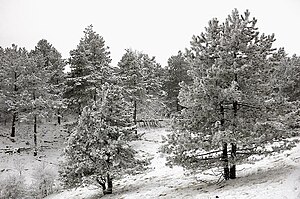Kedrovaya Pad Nature Reserve
|
Kedrovaya Pad Nature Reserve
|
||
|
Winter landscape in Kedrowaja Pad |
||
| location | Russia | |
| surface | 179 km² | |
| WDPA ID | 1726 | |
| Geographical location | 43 ° 5 ' N , 131 ° 30' E | |
|
|
||
| Setup date | 1925 | |

The Kedrowaja Pad Nature Reserve ( Russian Заповедник "Кедровая Падь" , Sapovednik "Kedrowaja Pad") is a protected area in the Far East of Russia . It was founded in 1925 and covers an area of 179 square kilometers. The reserve is an important refuge for the endangered Amur leopard . Kedrowaja-Pad has a joint administration with the Leopard Land National Park , which frames the strictly protected area.
landscape
The reserve is located in the extreme south of the Primorye region west of Vladivostok , near the border with China . It covers 179 square kilometers of mountain forest. The mixed forests represent a transition area between the Siberian taiga and subtropical forests. Half of the area is now covered by the Mongolian oak ( Quercus mongolica ). In the past, it was mainly promoted by forestry measures. Linden, maple, birch, elm, ash and various conifers such as the Manchurian fir and the Korean pine also thrive . Wild pears and rhododendrons also occur occasionally .
fauna
The reserve is one of the most important reserves for the endangered Amur leopard . Camera traps enabled a total of twelve different animals to be identified here and in the neighboring Leopardowy game reserve in 2011. In the previous years there were always seven to nine of these rare wildcats. In addition to the leopard, the Amur tiger and the collar bear are other great predators . In addition, the reserve is home to large populations of ungulates such as wild boar and Siberian deer , Sika deer and Siberian musk deer . Smaller predators include red foxes , raccoon dogs , Asian badgers , red martens , otters , fire weasels and Amur cats . Noticeable small mammals are squirrels, chipmunks and flying squirrels. The area is also home to numerous birds and reptiles, such as frog sparrows and tiger snakes .

